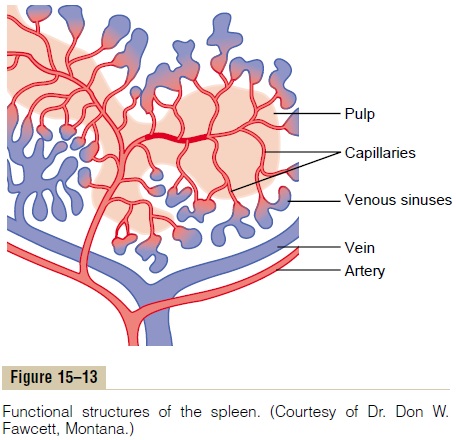Chapter: Medical Physiology: Vascular Distensibility and Functions of the Arterial and Venous Systems
Blood Reservoir Function of the Veins
Blood Reservoir Function of the Veins
As pointed out, more than 60 per cent of all the blood in the circulatory system is usually in the veins. For this reason and also because the veins are so compliant, it is said that the venous system serves as a blood reservoir for the circulation.
When blood is lost from the body and the arterial pressure begins to fall, nervous signals are elicited from the carotid sinuses and other pressure-sensitive areas of the circulation. These in turn elicit nerve signals from the brain and spinal cord mainly through sympathetic nerves to the veins, causing them to constrict. This takes up much of the slack in the circulatory system caused by the lost blood. Indeed, even after as much as 20 per cent of the total blood volume has been lost, the circulatory system often functions almost normally because of this variable reservoir function of the veins.
Specific Blood Reservoirs. Certain portions of the circu-latory system are so extensive and/or so compliant that they are called “specific blood reservoirs.” These include (1) the spleen, which sometimes can decrease in size sufficiently to release as much as 100 milliliters of blood into other areas of the circulation; (2) the liver, the sinuses of which can release several hundredmilliliters of blood into the remainder of the circula-tion; (3) the large abdominal veins, which can con-tribute as much as 300 milliliters; and (4) thevenousplexus beneath the skin, which also can contributeseveral hundred milliliters. The heart and the lungs, although not parts of the systemic venous reservoir system, must also be considered blood reservoirs. The heart, for instance, shrinks during sympathetic stimu-lation and in this way can contribute some 50 to 100 milliliters of blood; the lungs can contribute another 100 to 200 milliliters when the pulmonary pressures decrease to low values.
The Spleen as a Reservoir for Storing Red Blood Cells.
Figure 15–13 shows that the spleen has two separate areas for storing blood: the venous sinuses and the pulp. The sinuses can swell the same as any other partof the venous system and store whole blood.

In the splenic pulp, the capillaries are so permeable that whole blood, including the red blood cells, oozes through the capillary walls into a trabecular mesh, forming the red pulp. The red cells are trapped by the trabeculae, while the plasma flows on into the venous sinuses and then into the general circulation. As a con- sequence, the red pulp of the spleen is a special reser- voir that contains large quantities of concentrated red blood cells. These can then be expelled into the general circulation whenever the sympathetic nervous system becomes excited and causes the spleen and its vessels to contract. As much as 50 milliliters of concentrated red blood cells can be released into the circulation, raising the hematocrit 1 to 2 per cent.
In other areas of the splenic pulp are islands of white blood cells, which collectively are called the white pulp.
Here lymphoid cells are manufactured similar to those manufactured in the lymph nodes. They are part of the body’s immune system.
Blood-Cleansing Function of the Spleen—Removal of Old Cells Blood cells passing through the splenic pulp before entering the sinuses undergo thorough squeezing. Therefore, it is to be expected that fragile red blood cells would not withstand the trauma. For this reason, many of the red blood cells destroyed in the body have their final demise in the spleen. After the cells rupture, the released hemoglobin and the cell stroma are digested by the reticuloendothelial cells of the spleen, and the products of digestion are mainly reused by the body as nutrients, often for making new blood cells.
Reticuloendothelial Cells of the Spleen The pulp of the spleen contains many large phagocytic lined with similar cells. These cells function as part of a cleansing system for the blood, acting in concert with a similar system of reticuloendothelial cells in the venous sinuses of the liver. When the blood is invaded by infec- tious agents, the reticuloendothelial cells of the spleen rapidly remove debris, bacteria, parasites, and so forth. Also, in many chronic infectious processes, the spleen enlarges in the same manner that lymph nodes enlarge and then performs its cleansing function even more avidly.
Related Topics